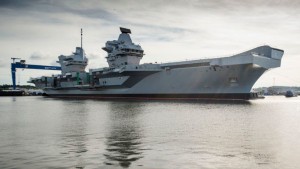After years of delays and cost overruns, the British Royal Navy’s HMS Queen Elizabeth is set to begin a series of critical sea trails that will help determine if the billions of pounds it took to build her were really worth it.
The vessel, built along with her sister ship HMS Prince of Wales, has been billed in British media as one of the most expensive military projects in the nation’s history, so there is a lot riding on its performance during its initial tests.
In total, both ships will cost a combined £6 billion, or $7.6 billion.
Captain Jerry Kyd (yes, actually Capt. Kyd) didn’t seem too worried about two very complicated maneuvers he’ll have to execute during the trials, according to The Guardian. One includes steering the carrier from the Rosyth dockyard basin where it was built, where there are just 50 centimeters between the ship’s bottom and the port’s seabed, according to the BBC. From there, Kyd will have to steer it under the Scotland’s three Forth Bridges with just a few meters to spare.
The HMS Queen Elizabeth will undergo six weeks of sea trials in the North Sea then return to Rosyth, where it was built, for adjustments before arriving at its home port of Portsmouth, on England’s south coast. It can carry up to 36 planes and 4 helicopters. More specifically, the Royal Navy plans on the carrier hosting 24 F-35s by 2023; U.S. Marines may also fly their own F-35s off the vessel as well, though the exact number is still being discussed.
Comparatively, the U.S. Navy’s new USS Ford is more than 1,100 feet in length, has 100,000 tons of displacement and can travel up to 30 knots per hour. At a cost of nearly $13 billion, the Ford eclipses the Royal Navy’s two new carriers combined. (We still do military spending better than anybody.)
The HMS Queen Elizabeth is expected to be fully operational by 2020 and have a life expectancy of 50 years. Destinations to which it may be deployed include the Persian Gulf and the South China Sea.
The lead-up to the HMS Queen Elizabeth’s sea trials is such a big deal because the carrier will help resurrect the Royal Navy’s glory days as an elite nautical force. As noted in The National Interest, the Royal Navy was a major aircraft carrier power during World War II and beyond until 1982 when it built three Invincible-class carriers that were smaller versions of ships it commissioned in the past. They were more suited for antisubmarine warfare against the Soviet Union. They weren’t, however, primed for a small, yet formidable enemy:
The 1982 Falklands War demonstrated the shortcomings of relying upon such small carriers. HMS Invincible, along with the older HMS Hermes, struggled to provide early warning and combat air patrol over the UK task force sent to reclaim the islands, and were unable to prevent Argentine air power from sinking six friendly warships and supply ships and damaging another nine.
But HMS Queen Elizabeth is better prepared for more amphibious situations as it be able carry “up to 250 Royal Marines or members of 16 Air Assault Brigade, WAH-64 Apache attack helicopters, AW159 Wildcat utility helicopters and Chinook heavy-transport helicopters,” The National Interest notes.
For many people in the British Navy community, the HMS Queen Elizabeth’s progress is likely to be seen with a strong degree of optimism. Its Navy can be seen as a carrier competitor again—even if the U.S. is now the undisputed post-World War II aircraft carrier nation.






































